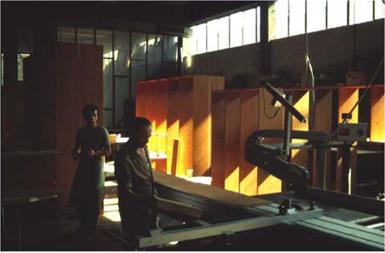We should make things as simple as possible but not simpler.1
Albert Einstein
In this book, workmanship refers to the quality apparent in the fabrication of furniture. Distinctions have been drawn between the workmanship of risk (handcraft) and the workmanship of certainty (machine and digital fabrication), but in every case, making furniture involves skills and a working knowledge of materials, tools, and the processes and methods of fabrication (Figure 8.1).
|

Furniture made with a high level of workmanship usually takes more time to make than one might anticipate, so it pays to plan and be organized. Before beginning the process of making furniture, it is wise to outline a list of the materials, tools, hardware, and supplies needed and to prepare a schedule to help guide the fabrication process. In addition, one should consider the time and skills necessary to make the furniture. Not only should one consider the quantity of materials necessary to make the furniture, but also the quality, availability, and cost of the materials specified.
For example, lumber is generally purchased at lumberyards or bought from timber merchants. Depending on its grade, lumber can have excellent figure or have natural surface qualities that may be undesirable, such as sapwood, knots, wormholes, or fruit marks. It is becoming difficult to find woods such as cherry in widths greater than 6 inches (15.2 cm) due to the demand for these species. Plywood is graded by its surface and core and can vary widely in quality from one side to the other side of a single sheet. The quality of its surface veneers and its core are graded using letter and numerical ratings.
Stone, especially granite and marble, can vary significantly in pattern and color within a single slab. The quality of plastics, metals, and glass, however, is generally consistent because of the uniformity of these materials and the production processes involved in their manufacture. The point is to keep in mind that some materials need to be hand selected by the designer, while others can be ordered over the phone or through the Internet due to their inherent uniform and consistent nature.
Orders for hard-to-find materials such as specialty fabrics, veneers, and woods can take several weeks. Sources for newer green materials such as wheat board, Medite II, and the newest copper and aluminum foams can take time to locate and secure. Today, searches are made easier with the assistance of the Internet. (Several web sites are listed in the bibliography.)
Most hand tools for working materials are available at local retail stores, as are common shop supplies such as glues, screws, dowels, bits, sandpaper, and finishing materials. But special hardware, larger tools, and additional equipment may be needed and may require extensive lead times to secure. In addition to searching for and securing the necessary materials and tools, make schedules for fabricating the work and maintain them.



